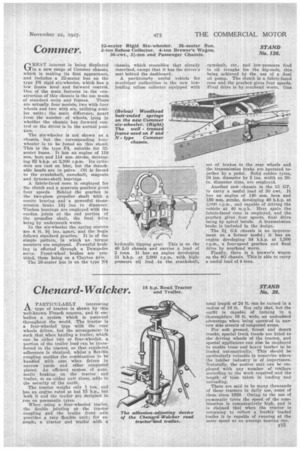Commer.
Page 141

If you've noticed an error in this article please click here to report it so we can fix it.
REAT interest is being displayed
in a new range of Commer chassis, which is making its first appearance, and includes a 32-seater bus on the type F6 rigid six-wheeler, which has a low frame level and forward control. One of the main features inthe construetian of this chassis is the use made of standard units and frames. There are actually, four models, two with four wheels and two with six, utilizing similar units; the main difference, apart from the number of wheels, lying in whether the chassis has forward control or the driver is in the normal position.
The six-wheeler is not shown as a chassis, but' the corresponding fourwheeler is to be found an this stand. This is the type F4, suitable. for 32seater buses. It has an engine of 110 mm. bore and 114 mm. stroke, developing 82 b.h.p. at 2,300 r.p.m. Its cylinders are -cast en bloc, but the detachable heads are in pairs. Oil is forced to the grankshaft, camshaft, magneto 'and dynamo-shaft bearings.
A fabric-faced cone is employed for the clutch and a separate gearbox gives four speeds. Behind the gearbox is the two-piece propeller shaft with a centre bearing and a powerful transmission brake 14i ins, in diameter. Timken bearings are employed with the cardan joints at the end portion of the propeller shaft, the final drive being by underneath worm.
In the six-wheeler the spring centres are 4 ft. 9f ins. apart, and the bogie follows standard practice. It is of the simple pattern, in which no torque members are employed. Powerful braking is effected through a Dewandre serve. Front-wheel brakes are provided, these being on a Clayton axle.
The 26-seater bus is on the type N4 chassis, which resembles that already described, except that it has the driver's seat behind the dashboard.
A particularly useful vehicle formunicipal authorities is the new lowloading refuse collector equipped with
hydraulic tipping gear. This is on the 40 LG chassis and carries a load of 2 tons. It has an engine developing 31 b.h.p. at 2,000 r.p.m. with highpressure oil feed to the crankshaft,
camshaft, etc., and low-pressure feed to oil troughs for the •big-ends, this being. achieved by the use of a dual oil pump. The clutch is a fabric-faced cone and the gearbox gives four speeds. Final drive is by overhead worm. One
set of brakes to the rear wheels and the transmission brake are Operated together by a pedal. Solid rubber tyres, 24 ins. diameter by 5 ins. width on 20in. diameter rims, are employed.
Another new chassis is the 13 GP, to carry a useful load of 30 cwt. It has an engine of 140 mm. bore and 180 mm. stroke, developing 40 b.h.p. at 2,000 r.p.m., and capable of driving the vehicle at 40 m.p.h. Here again the fabric-faced cone is employed, and the gearbox gives four speeds, final drive being by spiral bevels. A transmission brake is included in the design.
The 2i GA chassis is an improvement on a former model; it has an engine developing 54 b.h.p. at 1,500 r.p.m., a four-speed gearbox and final drive by overhead worm.
Finally, there is a brewer's wagon on the 4G chassis. This is able to carry a useful load of 4 tons.


















































































































































































































































































































